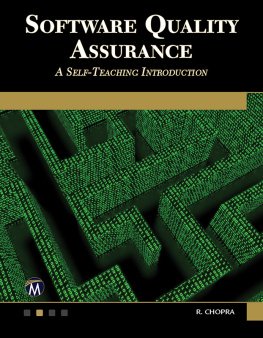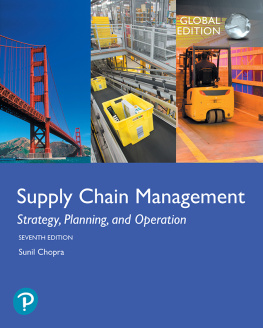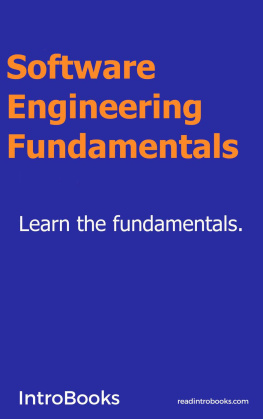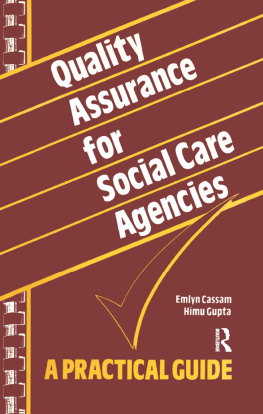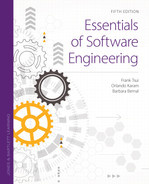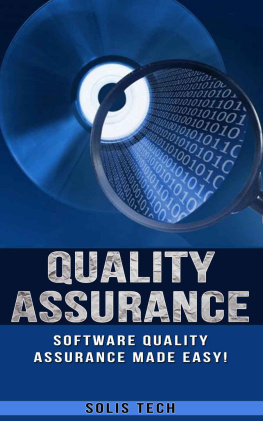SOFTWARE QUALITY
ASSURANCE
LICENSE, DISCLAIMER OF LIABILITY, AND LIMITED WARRANTY
By purchasing or using this book (the Work), you agree that this license grants permission to use the contents contained herein, but does not give you the right of ownership to any of the textual content in the book or ownership to any of the information or products contained in it. This license does not permit uploading of the Work onto the Internet or on a network (of any kind) without the written consent of the Publisher. Duplication or dissemination of any text, code, simulations, images, etc. contained herein is limited to and subject to licensing terms for the respective products, and permission must be obtained from the Publisher or the owner of the content, etc., in order to reproduce or network any portion of the textual material (in any media) that is contained in the Work.
MERCURY LEARNING AND INFORMATION (MLI or the Publisher) and anyone involved in the creation, writing, or production of the companion disc, accompanying algorithms, code, or computer programs (the software), and any accompanying Web site or software of the Work, cannot and do not warrant the performance or results that might be obtained by using the contents of the Work. The author, developers, and the Publisher have used their best efforts to insure the accuracy and functionality of the textual material and/or programs contained in this package; we, however, make no warranty of any kind, express or implied, regarding the performance of these contents or programs. The Work is sold as is without warranty (except for defective materials used in manufacturing the book or due to faulty workmanship).
The author, developers, and the publisher of any accompanying content, and anyone involved in the composition, production, and manufacturing of this work will not be liable for damages of any kind arising out of the use of (or the inability to use) the algorithms, source code, computer programs, or textual material contained in this publication. This includes, but is not limited to, loss of revenue or profit, or other incidental, physical, or consequential damages arising out of the use of this Work.
The sole remedy in the event of a claim of any kind is expressly limited to replacement of the book, and only at the discretion of the Publisher. The use of implied warranty and certain exclusions vary from state to state, and might not apply to the purchaser of this product.
SOFTWARE QUALITY
ASSURANCE
A Self-Teaching Introduction
RAJIV CHOPRA, PhD

MERCURY LEARNING AND INFORMATION
Dulles, Virginia
Boston, Massachusetts
New Delhi
Copyright 2018 by MERCURY LEARNING AND INFORMATION LLC. All rights reserved.
Original Title and Copyright: Software Testing and Quality Assurance: A Practical Approach, 5/e.
2016 by S.K. Kataria & Sons.
This publication, portions of it, or any accompanying software may not be reproduced in any way, stored in a retrieval system of any type, or transmitted by any means, media, electronic display or mechanical display, including, but not limited to, photocopy, recording, Internet postings, or scanning, without prior permission in writing from the publisher.
Publisher: David Pallai
MERCURY LEARNING AND INFORMATION
22841 Quicksilver Drive
Dulles, VA 20166
www.merclearning.com
(800) 232-0223
R. Chopra. Software Quality Assurance: A Self-Teaching Introduction.
ISBN: 978-1-683921-68-4
The publisher recognizes and respects all marks used by companies, manufacturers, and developers as a means to distinguish their products. All brand names and product names mentioned in this book are trademarks or service marks of their respective companies. Any omission or misuse (of any kind) of service marks or trademarks, etc. is not an attempt to infringe on the property of others.
Library of Congress Control Number: 2017960720
181920321 This book is printed on acid-free paper in the United States of America
Our titles are available for adoption, license, or bulk purchase by institutions, corporations, etc.
For additional information, please contact the Customer Service Dept. at 800-232-0223(toll free).
All of our titles are available in digital format at authorcloudware.com and other digital vendors. The sole obligation of MERCURY LEARNING AND INFORMATION to the purchaser is to replace the book, based on defective materials or faulty workmanship, but not based on the operation or functionality of the product.
CONTENTS
CHAPTER 1
INTRODUCTION TO SOFTWARE TESTING
Inside this Chapter:
1.0. INTRODUCTION
Testing is the process of executing the program with the intent of finding faults. Who should do this testing and when should it start are very important questions that are answered in this text. As we know software testing is the fourth phase of the software development life cycle (SDLC). About 70% of development time is spent on testing. We explore this and many other interesting concepts in this chapter.
1.1. THE TESTING PROCESS
Testing is different from debugging. Removing errors from your programs is known as debugging but testing aims to locate as yet undiscovered errors. We test our programs with both valid and invalid inputs and then compare our expected outputs as well as the observed outputs (after execution of software). Please note that testing starts from the requirements analysis phase only and goes until the last maintenance phase. During requirement analysis and designing we do static testing wherein the SRS is tested to check whether it is as per user requirements or not. We use techniques of code reviews, code inspections, walkthroughs, and software technical reviews (STRs) to do static testing. Dynamic testing starts when the code is ready or even a unit (or module) is ready. It is dynamic testing as now the code is tested. We use various techniques for dynamic testing like black-box, gray-box, and white-box testing. We will be studying these in the subsequent chapters.
1.2. WHAT IS SOFTWARE TESTING?
The concept of software testing has evolved from simple program check-out to a broad set of activities that cover the entire software life-cycle.
There are five distinct levels of testing that are given below:
a. Debug: It is defined as the successful correction of a failure.
b. Demonstrate: The process of showing that major features work with typical input.
c. Verify: The process of finding as many faults in the application under test (AUT) as possible.
d. Validate: The process of finding as many faults in requirements, design, and AUT.
e. Prevent: To avoid errors in development of requirements, design, and implementation by self-checking techniques, including test before design.
There are various definitions of testing that are given below:
Testing is the process of exercising or evaluating a system or system component by manual or automated means to verify that it satisfies specified requirements.
[IEEE 83a]
OR
Software testing is the process of executing a program or system with the intent of finding errors.
Next page
